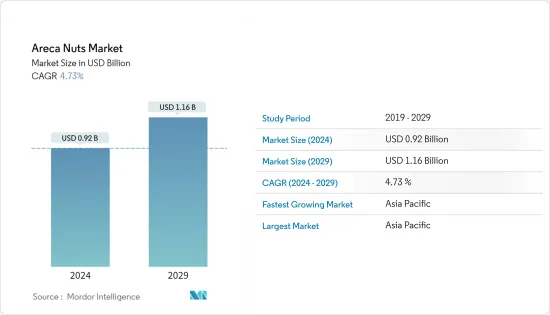PUBLISHER: Mordor Intelligence | PRODUCT CODE: 1440108

PUBLISHER: Mordor Intelligence | PRODUCT CODE: 1440108
Areca Nuts - Market Share Analysis, Industry Trends & Statistics, Growth Forecasts (2024 - 2029)
The Areca Nuts Market size is estimated at USD 0.92 billion in 2024, and is expected to reach USD 1.16 billion by 2029, growing at a CAGR of 4.73% during the forecast period (2024-2029).

Key Highlights
- In Southeast Asia, the areca nut is a popular commercial fruit. They are available in two varieties in the market - red and white. White areca nut is made from mature nuts, while red areca nut is made from green areca nuts. Areca nuts contain polysaccharides, polyphenols, proteins, and fiber.
- According to FAOSTAT, the major producers of areca nuts include India, Bangladesh, Myanmar, Indonesia, China, Taiwan, Sri Lanka, Thailand, and Nepal. Furthermore, the major importing countries of areca nuts are Thailand, Bangladesh, Vietnam, India, Singapore, and China. Indonesia, Thailand, Myanmar, Singapore, Sri Lanka, and India were some of the major exporters of areca nuts globally in 2021, as per a database published by ITC Trade map.
- The ever-growing demand for areca products, such as pan, scented supari, and pan masala in countries like Sri Lanka, Nepal, the United Arab Emirates, Mexico, Thailand, and Singapore drives the growth of the areca nut market. The majority of areca nut production is likely to be concentrated in South Asia, especially India. Areca nut has severe limitations to growth which include being dependent on the weather conditions, growth of the consumer industries, and government rules for consumer industries. The consistent consumption of areca nut causes diseases that include oral and throat cancer.
- Due to several people having been infected by the consumption of areca nut, the government of India and various other governments have posed various regulations over the areca nut production and consumer industries. Furthermore, the increasing awareness of health and fitness amongst people has raised concerns over areca nut consumption, thus, resulting in a major obstacle to growth.
Areca Nuts Market Trends
Increasing Imports from India
The demand for areca nuts is rising in India due to their usage in traditional customs and consumption in various forms. The usage of these nuts in betel leaves with different flavors is enhancing the market for areca nuts in the country. They are used in various forms, including fresh, dried, baked, boiled, roasted, and cured. Dehusked areca nuts are used in a raw or processed form, generally with tobacco. These are also majorly used in different industrially manufactured products, such as gutka and pan masala. These factors are further expected to increase the imports of India.
In 2021, the price of tender areca nuts reached an all-time high due to a sharp decline in production caused by various diseases affecting areca nut palms. Areca nut palms are susceptible to various diseases, such as fruit rot disease, bud rot, and yellow leaf disease due to the heavy rain. The shortage in the arrival of the commodity, owing to a decline in yield and the huge demand for the product in the market, especially in Karnataka, was the major reason for the sudden spurt in the price of the crop. Therefore, all these factors, coupled with reduced domestic production affected by diseases and the steadily growing demand, led to increased imports of the commodity.
Asia-Pacific Dominates the Market
The growth of the areca nuts market is mainly due to the rising consumption of nuts in both developed and developing countries of Asia-Pacific. The Asia-Pacific region holds about 90% of the market for areca nuts. India is the largest producer and the biggest consumer of areca nuts in the world. Almost all the demand for areca nuts is met by India, Bangladesh, Indonesia, Thailand, Sri Lanka, and Myanmar.
However, the per capita consumption of areca nuts is high in Myanmar, followed by Bangladesh, India, Indonesia, and China. The consumption is further expected to increase in the near future as the consumption of these nuts in different processed foods continues to increase.
Despite the danger to health, the betel-nut industry is booming. In the province, betel nuts are deeply ingrained into the cultural fabric. However, in 2021, China banned the promotion of betel nuts, the addictive seeds of areca palm trees, on television, radio, and online programs because of their cancer-causing risks.
Additional Benefits:
- The market estimate (ME) sheet in Excel format
- 3 months of analyst support
TABLE OF CONTENTS
1 INTRODUCTION
- 1.1 Study Assumptions and Market Definition
- 1.2 Scope of the Study
2 RESEARCH METHODOLOGY
3 EXECUTIVE SUMMARY
4 MARKET DYNAMICS
- 4.1 Market Overview
- 4.2 Market Drivers
- 4.3 Market Restraints
- 4.4 Value Chain/Supply Chain Analysis
5 MARKET SEGMENTATION
- 5.1 By Geography (Production Analysis by Volume, Consumption Analysis by Volume and Value, Import Analysis by Volume and Value, Export Analysis by Volume and Value, and Price Trend Analysis)
- 5.1.1 North America
- 5.1.1.1 United States
- 5.1.1.2 Canada
- 5.1.1.3 Mexico
- 5.1.2 Europe
- 5.1.2.1 Germany
- 5.1.2.2 United Kingdom
- 5.1.2.3 Spain
- 5.1.2.4 Italy
- 5.1.3 Asia-Pacific
- 5.1.3.1 China
- 5.1.3.2 India
- 5.1.3.3 Indonesia
- 5.1.3.4 Myanmar
- 5.1.4 South America
- 5.1.4.1 Chile
- 5.1.4.2 Brazil
- 5.1.5 Africa
- 5.1.5.1 South Africa
- 5.1.1 North America
6 MARKET OPPORTUNITIES AND FUTURE TRENDS




